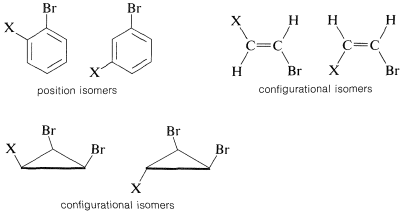
Chemical Shift and Stereochemistry
 المؤلف:
John D. Roberts and Marjorie C. Caserio
المؤلف:
John D. Roberts and Marjorie C. Caserio
 المصدر:
Basic Principles of Organic Chemistry : LibreTexts project
المصدر:
Basic Principles of Organic Chemistry : LibreTexts project
 الجزء والصفحة:
........
الجزء والصفحة:
........
 11-1-2022
11-1-2022
 1993
1993
Chemical Shift and Stereochemistry
The value of nmr spectroscopy in structure determination lies in the fact that chemically different nuclei absorb at different field strengths. In later sections we will be concerned with correlating the chemical shifts with structural features. However, before proceeding furher it is extremely important that you be able to identify the number and kind of nonequivalent protons in a given structure, and therefore the number of chemical shifts to expect. This number is not always self-evident, especially when subtle factors of stereochemistry intervene. For this reason, we suggest that you inspect structures 3-5 to convince yourself that the protons labeled with different letter subscripts in any one molecule are indeed chemically different.

One way of checking whether two protons are in equivalent environments is to imagine that each is separately replaced with a different atom or group. If the product of replacing HA is identical with that obtained by replacing HB, then HA and HB are chemically equivalent. If the two products are nonidentical, then HA and HB are nonequivalent. For example, replacement of HA or HB in 3, 4, and 5 by an atom X would give different products. Therefore, HA and HB are nonequivalent in 3, 4, and 5.

Matters become more complicated with substances such as 6 and 7:

Notice that 6 represents a chiral molecule and if HA and HB each are replaced with X we get 8 and 9, which are diastereomers. You can verify this with molecular models if necessary. Diastereomers have different chemical and physical properties; therefore HA and HB in 6 are nonequivalent. They often are called diastereotopic hydrogens.

What of the two methylene protons in ethanol, 7, which we have labeled as HA HA'? Are they identical? In a sense they are not identical because, if each were replaced by X, we would have a pair of enantiomers. Therefore, HA and HA' sometimes are called enantiotopic hydrogens.

But, you will recall that enantiomers are chemically indistinguishable unless they are in a chiral environment. Therefore we expect shifts of enantiotopic hydrogens to be identical, unless they are in a chiral environment. To summarize, enantiotopic protons normally will have the same chemical shifts, whereas diastereotopic protons normally will have different chemical shifts.
We so far have ignored the relationship of chemical shifts to conformational equilibria. Consider a specific example, 1,2-dibromoethane, for which there are three staggered conformations 10a, 10b, and 10c:

Each of these conformations is expected to have its own nmr spectrum. The two gauche forms, 10a and 10b, are enantiomers and their spectra should be identical. The hydrogens HA in 10a each are trans to the bromine on the adjacent carbon, while the HB hydrogens are cis to the same bromines. Consequently the HA and HB hydrogens are nonequivalent and would be expected to have different chemical shifts. In contrast, all of the hydrogens of the anti conformer, 10c, are equivalent and would have the same chemical shift. Therefore we would expect to observe three chemical shifts arising from HA, HB, and HC for a mixture of 10a, 10b, and 10c. However, the actual spectrum of 1,2-dibromoethane shows only one sharp proton signal under ordinary conditions. The reason is that the magnetic nuclei can absorb the exciting radiation. The result is that we observe an average chemical shift, which reflects the relative shifts and populations of the three conformers present. If we can go to a sufficiently low temperature to make interconversion of the conformations slow (on the order of 10 times per second), then we will expect to see the three different chemical shifts HA, HB, and HC with intensities corresponding to the actual populations of the conformations at the sample temperature. This is one example of the effect of rate processes on nmr spectra.
 الاكثر قراءة في التشخيص العضوي
الاكثر قراءة في التشخيص العضوي
 اخر الاخبار
اخر الاخبار
اخبار العتبة العباسية المقدسة


